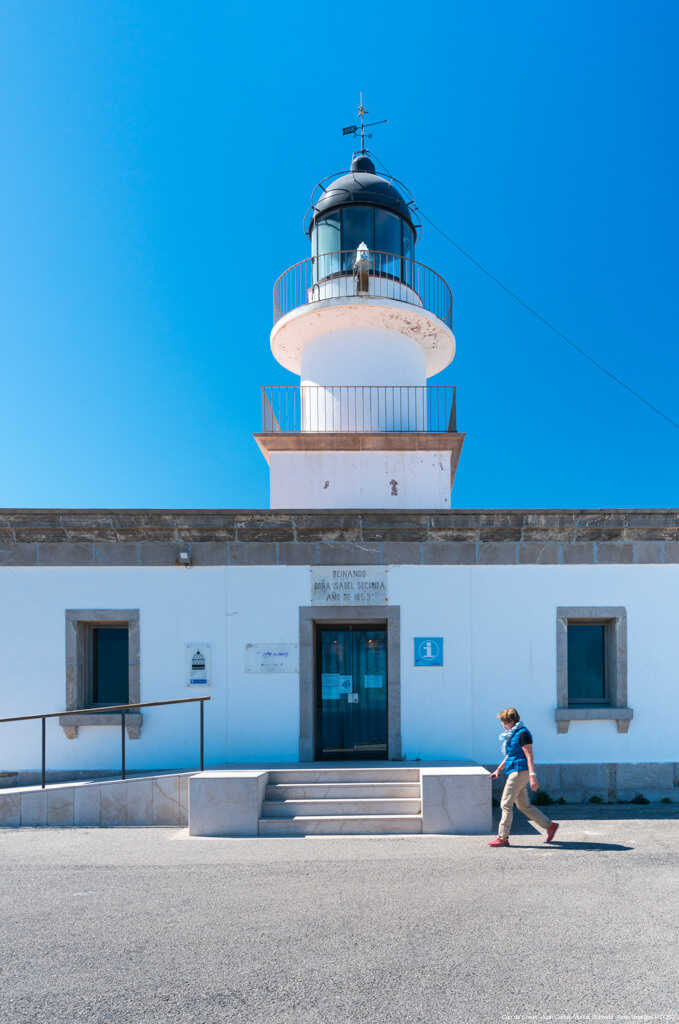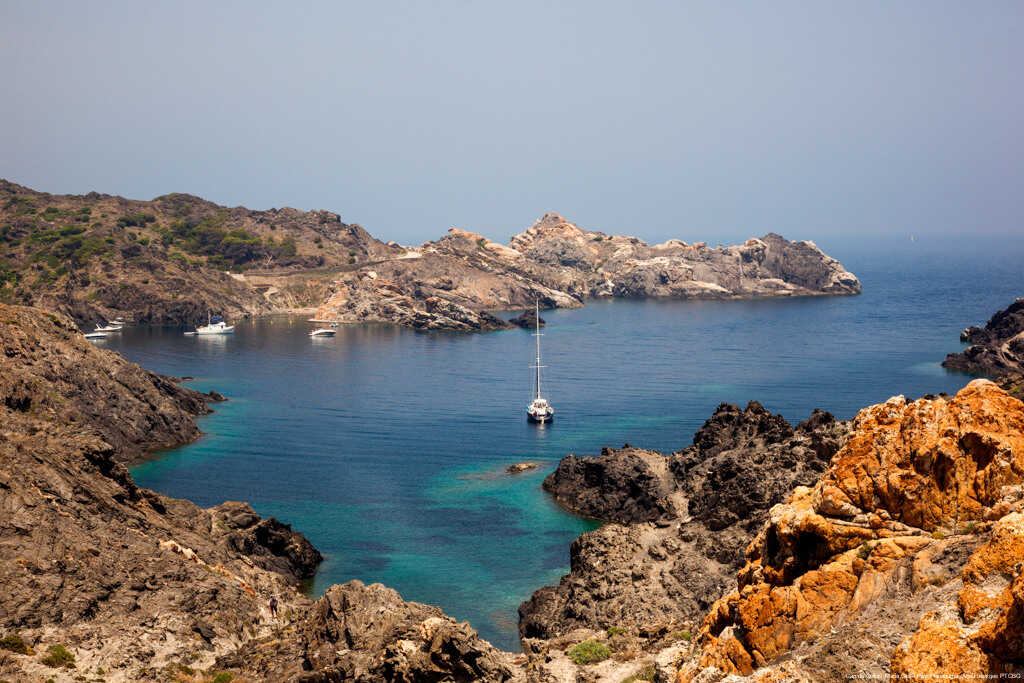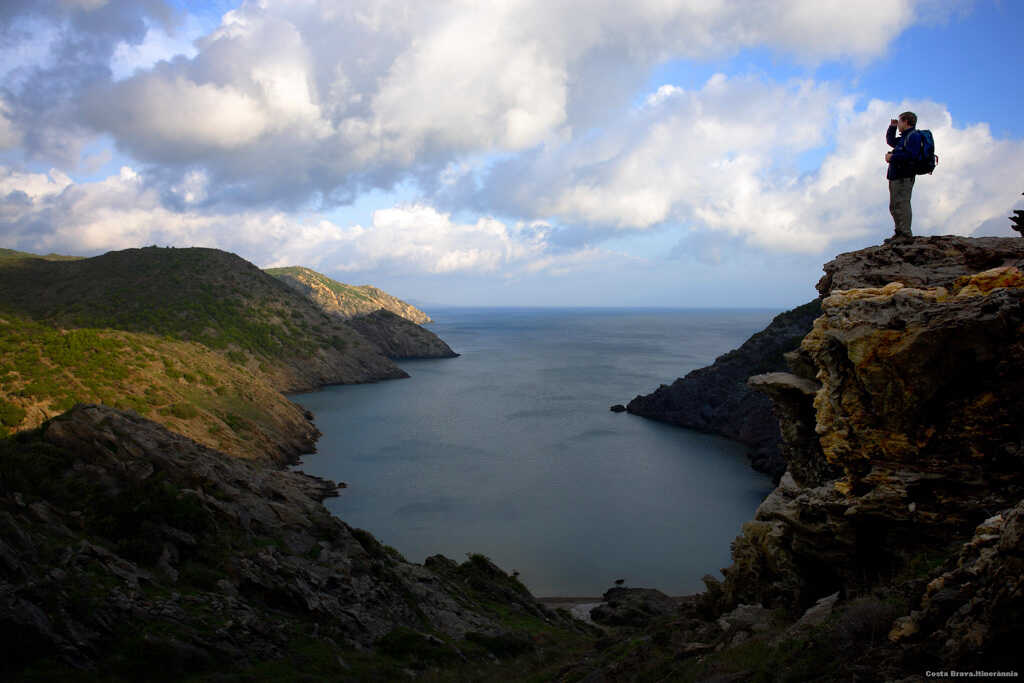Have you been to Cap de Creus? This is the easternmost tip of the Iberian Peninsula and one of the most magical parts of the Costa Brava. Keep reading and you’ll find out all the details!
The Cap de Creus Natural Park stretches from Roses to Llança and Cadaqués to Vilajuïga, constituting one of the most special and beloved areas of the Costa Brava, due to its rugged landscape reminiscent of craters on the moon and a nature reserve with a high degree of biodiversity.
It’s a spot worth framing, one that will enable you to discover the wildest part of the Costa Brava, with great cliffs and beautiful coves that invite a visit by a bather without a word.
Plenty of excursions await in Cap de Creus, whether they are along the Camí de Ronda (coastal path) that runs across the Park with the GR-11, beside the sea or through the woods and meadows. You’ll also be able to view the landscapes that inspired Salvador Dalí, visit the Sant Pere de Rodes Monastery or stroll around the villages bordering the Park, including: Llançà, Port de la Selva, Selva de Mar, Cadaqués, Roses, Palau-saverdera, Vilajuïga and Pau.
To make your visit easier, Càmpings de Girona lists all the must visit sights in this wonderful natural setting.
Let’s go, here they all are!

Let’s start with Cap de Creus Lighthouse located at the easternmost tip of the peninsula, which has remained in operation since 1847 to indicate to the boats sailing in the area that there’s land nearby and that care must be taken not to collide with the coastal rocks. After the lighthouse there was a watchtower that was used to look out for pirate raids in the territory.
It’s the best-known vantage point in Cap de Creus, due to the panoramic views that can be admired and its proximity to some of the most delightful coves in the area.
If you want to go there for lunch, you can stop off at Cap de Creus Lighthouse Restaurant, a small establishment next to the lighthouse where freshly caught fish and paellas are the main dishes.
“This part between Camell and Àguila that you know and love as much as I do is and must continue forever as pure geology, without anything that can dilute it; I make this a matter of principle. It’s a mythological setting made for the gods rather than men and it must continue just as it is.”
Salvador Dalí
A place of dreams, years ago this area which forms part of the Cap de Creus Natural Park since 1998, had been occupied by a holiday resort. Its demolition and the subsequent restoration of the landscape meant that one of the most emblematic places in the Empordà can be enjoyed once again.
You can walk along a path that inspired great artists like Salvador Dalí. The sea salt and the north wind have left their marks on the landscape, giving animal-like shapes to many of the rock structures. This is an ideal excursion to do with the little ones; as you walk among the rocks on a nice and simple path you’ll be able to play at guessing the animal shapes of these rocks.
This magnificent setting conceals the fisherman’s hut where Salvador Dalí lived and felt inspired to create much of his work.
If you’re visiting the area, it’s highly advisable to stop off at the Salvador Dalí House-Museum in order to delve into the mind of the greatest exponent of surrealism and understand how he perceived and portrayed the landscape of Cap de Creus in his works.
You can obtain further information on the visiting hours and ticket prices on the Dalí Foundation website.
Another sight you shouldn’t miss in Cap de Creus is the Sant Pere de Rodes Monastery. Located in Serra de Vereda, it’s regarded as a Romanesque treasure and one of the most important monasteries in Catalonia.
Its construction date isn’t clear; according to some legends, the first humans arrived in this area in the 9th century and some Benedictine monks were the founders of this building, which was initially designed to guard over the remains of Saint Peter and other Saints.
Although the origins are unclear and remains have been found dating back further than the 9th century, its age of splendour came between the 11th and 14th centuries, when it became the main spiritual centre run by Benedictine monks in the county of Empúries.
A visit to the incredible Sant Pere de Rodes Monastery is a must, and, if you’re interested, Càmpings de Girona can provide more information so you can prepare for your visit.
Very close to the Sant Pere de Rodes Monastery stands the Sant Salvador de Verdera Castle, a building dating back to the 9th century whose ruins have been conserved.
Rather than visiting the castle, we suggest going on a short excursion between the Monastery and the Castle, walking along a pleasant path until you reach one of the most incredible viewpoints in the Empordà. It offers spectacular views of Cap de Creus, its towns and other landmarks such as the Empordà Natural Park Wetlands.
A The town of Roses is one of the largest municipalities in Cap de Creus and one of the most important ones in terms of its heritage, with the Trinity Castle, a megalithic ensemble, the anti-raid shelter, the Citadel of Roses and much more.
During your visit to Cap de Creus, we recommend stopping off at the Citadel of Roses, listed as a Cultural Asset of National Interest in 1993. This is a Renaissance-style fortification which has played an important role throughout history due to its geographical location, constituting a natural port and a strategic point to ensure control of the territory.
If you have time, we recommend a visit to find out how our ancestors in this territory lived, given that much of the Greek and Roman city of Rhode, the high-mediaeval monastery of Santa Maria de Roses, the old town of Roses and its medieval fortifications located inside the citadel are still conserved.
For further information, go to the Roses official tourism website.
Cap Norfeu is located to the south-east of Cap de Creus, forming a maritime peninsula which stretches about two kilometres into the Mediterranean Sea. This formation is located between Jóncols Bay and Montjoi Bay, where you’ll find two magnificent coves.
This location in the Cap de Creus Natural Park is renowned for being an integral protection zone, thanks to the great terrestrial and marine biodiversity that’s been preserved. This is why it’s one of the favourite destinations for divers from all over the world, who gather in this area to catch glimpses of the underwater spectacle.
The Empordà Natural Park Wetlands stretches over the Alt Empordà county, covering an area of about 4,722.7 hectares until it links up with the Cap de Creus Natural Park.
The lakes area, called “Els Estanys”, lies closest to Cap de Creus and it’s a place of great scenic beauty where you’ll be able to see different species of birds and, depending on the time of year, horses walking around the lakes.
Cap de Creus conceals some of the most spectacular coves and beaches on the Costa Brava. Càmpings de Girona will reveal the most outstanding ones, but, if you do some excursions around the area, you’ll discover many more.
This nudist cove, close to Cap de Creus Lighthouse, is one of the most emblematic ones due to its steep landscape surrounded by vegetation and its distance from civilisation.
It’s characterised by the rocky seabed and white sand, a home for numerous marine species. A beach ideal for snorkelling fans.
Just below the Cap de Creus Lighthouse lies Cala Fredosa, a wonderful beach that was previously used to deliver provisions to the residents in the area.
Another feature of Cala Fredosa is that it receives the first rays of sunlight each day of the whole Iberian Peninsula. So, if you want to be one of the privileged few and see one of the best sunrises in the Mediterranean, we recommend a morning swim in this cove.
Another beach we can’t fail to mention is Cala Jóncols. Bordering Cadaqués and Roses, this unspoilt cove, only accessible along the coastal path from Cala Montjoi, is a place of great natural beauty.
Like the vast majority of the coves in Cap de Creus, it’s a paradise for snorkelling and diving fans.
Near the Cala Jóncols we can find Cala Montjoi, an unspoilt location and a little paradise for diving lovers, who can dive into clear waters full of marine species such as lobsters, moray eels, conger eels and fish of all colours.
We complete our own top five coves and beaches in Cap de Creus with one that’s a little different from the previous ones.
Cau del Llop Beach is located in Llançà and easier to reach than the other ones. If you’re going with your family or you just don’t want to have to walk so far to get to the beach, this is one of the best options, given that, apart from the easy access, the beach is in an unbeatable setting.

The stretch of the Coastal Path between Roses and Port de la Selva will take you along some of the most picturesque routes on the Costa Brava as you discover some of the most magical places in Cap de Creus Natural Park.
You can start the route in Roses and head towards Cala Montjoi, where you can follow the cliff path beside the sea. You’ll be able to observe many different and changing landscapes as you progress until you reach the Cap de Creus Lighthouse, one of the wildest places, with steep rocks and large cliffs. You can continue to Port Lligat and end this stretch with an enjoyable swim.
On the way you’ll see stunning coves and beaches that will invite you to stop and bathe in their clear turquoise waters.

The Cap de Creus Natural Park encompasses several towns worth making a stop in; we’ll tell you more about some of them so you can identify the features that make them unique and the sights you shouldn’t miss.
A fishing village in Cap de Creus with white houses that lies close to the French border. It’s renowned for its coves, the steep coastline and the fact that it’s one of the most important towns in the area, which means it has all kinds of services.
During your visit to Llançà you must go on a walk through the old town, around the fishing port and along the seafront.
We continue with Port de la Selva, another fishing village with white houses in Cap de Creus. The setting for this town is similar to that of Llançà and it also provides all kinds of services for tourists and residents.
Some of the landmarks in the town are the centre, the traditional fishing port, Punta S’Arnella Lighthouse, the Santa Maria de les Neus Church and the promenade. This village is also very close to the Sant Pere de Rodes Monastery.
This village, located in the Cap de Creus Natural Park and very close to Port de la Selva, has its origins in mediaeval times and it still preserves this character, as reflected in the cobbled streets and the Church of Sant Esteve dating back to the 10th century. You’ll also see other elements reminiscent of times gone by, such as the defensive towers spread around the village.
We definitely recommend a visit to this village, which, although it isn’t as well-known as the others in the area, is very useful for understanding the character and landscape of this peculiar territory.
In Cadaqués you’ll find a charming town, among the ones visited most often on the Costa Brava. The white houses, the beaches, the bohemian aura created by artists from all around and, above all, the greatest exponent of surrealism, Salvador Dalí, have popularised the name of this town around the world.
You’re sure to love the visit to Cadaqués and, very close to it, you’ll find Portlligat, a small residential area with the Salvador Dalí House-Museum. There’s also access to Cap de Creus Lighthouse and Tudela nearby.
Roses is one of the largest towns close to Cap de Creus, offering all visitors a cultural and natural heritage and a never-ending range of activities in the area to be enjoyed.
Some of the most important landmarks are the Citadel, the Trinity Castle, the megalithic settlement, the Empordà Natural Park Wetlands, the Visigothic Castrum, the old town and the air-raid shelter.
Despite not being one of the most tourist-geared municipalities in the Cap de Creus area, the village of Palau-saverdera conceals little treasures such as the Clock Tower, a building that tells the time for the whole village, and the Romanesque Church of Sant Joan dating back to the 11th century.
In the summer, it’s an excellent option if you want to visit a village away from the coast and enjoy the peace and quiet.
Another important village in Cap de Creus is Vilajuïga, a small municipality with features characteristic of mediaeval times which is renowned for the growing of vines used by many wines with the Empordà designation of origin.
Another landmark in this Empordà village is the set of megalithic dolmens spread around the municipality. In addition, on a nearby peak you’ll find the 12th-century Quermançó Castle, which was occupied by the troops of King John II.
We’ll complete the set of towns in Cap de Creus by mentioning Pau, a village located in the Serra de Rodes and close to the Muga river. The surrounding area also features megalithic settlements that demonstrate the existence of ancient civilisations in the region.
We should also highlight the Sant Martí Church, dating back to the 11th and 13th centuries. It has a peculiar façade built with five semicircular archivolts resting on pillars adorned with capitals and plant and zoomorphic decorations. Finally you’ll see a castle, known as Cal Marquès that’s privately owned.
Now that you have seen the highlights of Cap de Creus and its towns and coves, how about learning more about the best restaurants where you can enjoy a good meal?
The Cap de Creus Natural Park doesn’t have many restaurants, as it isn’t a well-developed area so as to preserve the natural environment and landscape of this unique territory. Therefore, if you’re on a trip in the area we suggest two options: (1) bring a picnic or a sandwich from home or (2) stop at the Cap de Creus Lighthouse Restaurant, where you can enjoy excellent dishes cooked with fresh fish and rice dishes that will make your mouth water.
If you want to visit the towns in Cap de Creus, another option is to eat at one of the restaurants mentioned above.
You can reach the Cap de Creus area by car via the AP7 motorway (direction Girona > Roses) and then select the town you want to go to. Access to certain areas of the Natural Park is restricted so you should take care when you park to avoid fines.
You can also reach the Cap de Creus Natural Park by public transport, in one of the shuttle buses that leaves Cadaqués every 20 minutes and goes as far as Cap de Creus Lighthouse.
From 1 June to 30 September 2021 access by car is restricted to 9:30 am to 8:00 pm. However, a free car park has been set up in Corral d’en Morrell, near the town of Cadaqués. Visitors can park their cars there and catch a bus to the Cap de Creus Lighthouse.
Another option for parking in Cap de Creus is to leave your car in one of the municipalities with access to the Park, such as Port de la Selva, Cadaqués, Llançà or Roses, and go there on foot via the coastal path.
AllStaying at a campsite in the Cap de Creus Natural Park area is a privilege. Nature lovers can enjoy the scenery by snorkelling, diving or sailing in one of the most charming places on the Mediterranean.
The campsites include: Camping Cadaqués, Camping Port de la Selva, Camping Port de la Vall, Camping Laguna, Camping Rubina Resort, Camping Mas Nou, Camping Castell Mar, Camping Rhodes, Camping Salatà, Camping Jonca Mar and Camping Cala Montjoi.
Are you planning an excursion to Cap de Creus? Apart from when it’s sunny, it’s important to take a look at the weather forecast to avoid the windiest days, as the north wind here can exceed 100 km/h.
We share the 7-day forecast so that you can plan your excursion to Cap de Creus.
Enjoy this magical destination on the Costa Brava!